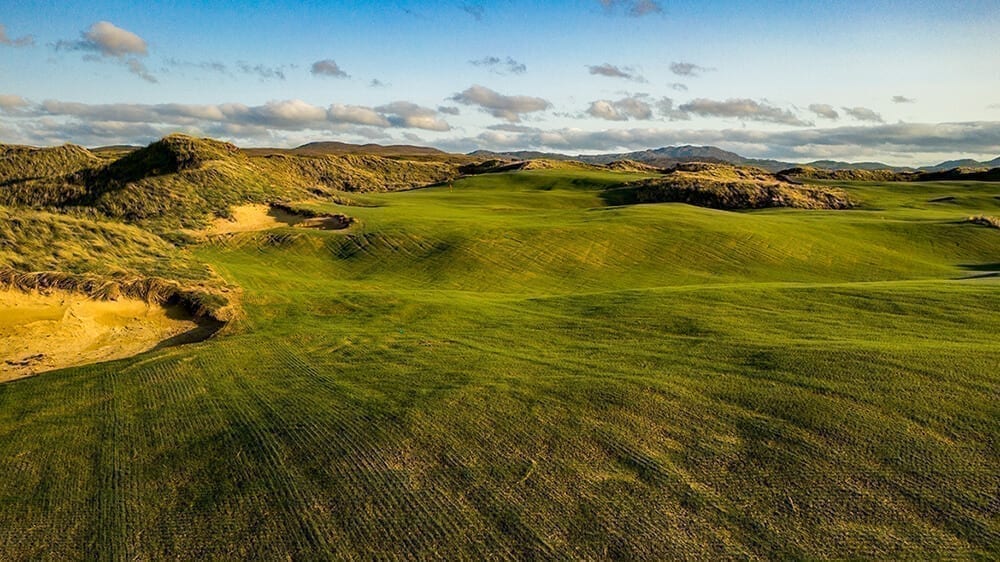The northwest of Ireland is getting a new course this summer—one with a name that’s easy to remember. St. Patrick’s Links will be Tom Doak’s first creation on the Emerald Isle, and it’s likely to spur even more visits to this underappreciated part of the links golf world.
Doak’s par-72, 6,826-yard course will be the third 18-hole links at the spiffy Rosapenna Golf Hotel & Resort in County Donegal (along with an additional nine holes known as the “Coastguard Holes”), giving the resort a total of 63 holes. The other 18s, Pat Ruddy’s celebrated Sandy Hills Course and The Old Tom Morris Course (initially laid out by Old Tom but later modified by early 20th-Century giants Harry Vardon, James Braid, and Harry Colt) have made Rosapenna a must-visit destination for anyone venturing to that part of Ireland for years. But now, with Doak’s new 18 debuting soon along Tramore Beach and offering stunning views of Sheephaven Bay, I expect Rosapenna to earn a spot on even more itineraries.

The St. Patrick’s site was actually slated to host two other golf courses prior to its purchase by the Casey family that owns and manages Rosapenna. Nicklaus Design had begun working on a renovation of one of those proposed tracks, the Maheramagorgan Course (original design by Eddie Hackett), but the Great Recession intervened and neither it nor the second course planned for the site, the Trá Mór, were completed. Doak convinced the new owners, the Caseys, to create one spectacular course there instead of two, using the best of the 300-plus acres for his Irish 18. And for the first time in his career, Doak helped the owners source funding for the project, and in the process became a part-owner himself.
I spoke with Doak to get the story on St. Patrick’s Links—and his thoughts on what golfers might enjoy most about the new course.

“By the time I saw the site,” he said, “it was hard to make out very much of the originally planned golf courses. They kept mowing fairways in order to keep the status of the property as a golf course all these years. But they just kept getting smaller and smaller, until by the time I saw it, most of them were about 10 yards wide. So, it was really hard to visualize what those golf courses were. They had a lot of holes packed onto that site. I think the only [initially planned] holes that really feel similar to the new holes are the second half of the [377-yard par-four] 1st hole and our 2nd hole [389-yard par four], and then some of what’s our 7th and 8th [404 and 389-yard par fours]. Although, I think those were supposed to play in the opposite direction to what we’re playing now. The 2nd hole is pretty much one of the holes from the Trá Mór Course.
“There were a lot of cool features of the site, and the main thing was you had that big hill in the middle [called “Maheramagorgan”], with a stunning view from the top of it. But working your way up there was a real puzzle. And I didn’t think you wanted to keep doing that a lot of times. So, to me, the lower parts of the site offered the best topography on the site for golf, alleys just the right width for a golf hole.”

St. Patrick’s two nines both return to the clubhouse. Some of its holes take you to the edge of the beach, with the 14th green perched right on the shoreline. But you can expect all of them to be as scenic as they are testing, especially when the wind is whipping in off the bay. Asked to name a few of the special moments golfers could expect when they play the course, Doak pointed to several.
“I haven’t even seen the golf course entirely finished,” he says, “but I would say that 2nd hole is just a beautiful hole from the tee and a very exciting-looking hole that’s right there in plain view. The two most dramatic moments on the golf course are probably the tee shot at the [par-five] 4th playing down along the beach, and the tee shot on the [508-yard par-five] 16th, where it comes back in the other direction from as high as we get on the hill. They’re both really big views, but they’re very different. On hole No. 4, you’re playing into the wind off a high, elevated tee that drops all the way down to the fairway. And you’re thinking, ‘How is this not going to get really held up by the wind?’ Whereas on 16, there’s not as much elevation. But the only fairway I can compare that fairway to is the 10th at Augusta National. I mean it just goes… it’s a big wide fairway that just tilts down and left really hard. And so playing it downwind, you’re going to be able to hit it forever there if you hit a big draw off the tee.

“I think all of the par threes are dramatic. And the [455-yard par-four] 11th hole, which is kind of out in the land that a lot of people would have said, ‘Oh, that’s the least exciting land of the bunch,’ the 11th is actually a terrific hole. There’s just a ton of undulation in the fairway and by far the wildest green on the golf course.”
When you put it all together—a hilly site hard by the sea, Doak’s design talent, and a comfy resort with 45 other holes to keep you entertained—you’ve got a golf destination that’s sure to please even the most discriminating of golf travelers. And one where you can be sure that every day is likely to have a touch of St. Patrick’s Day. Sláinte.

What do you think of St. Patrick’s Links?






